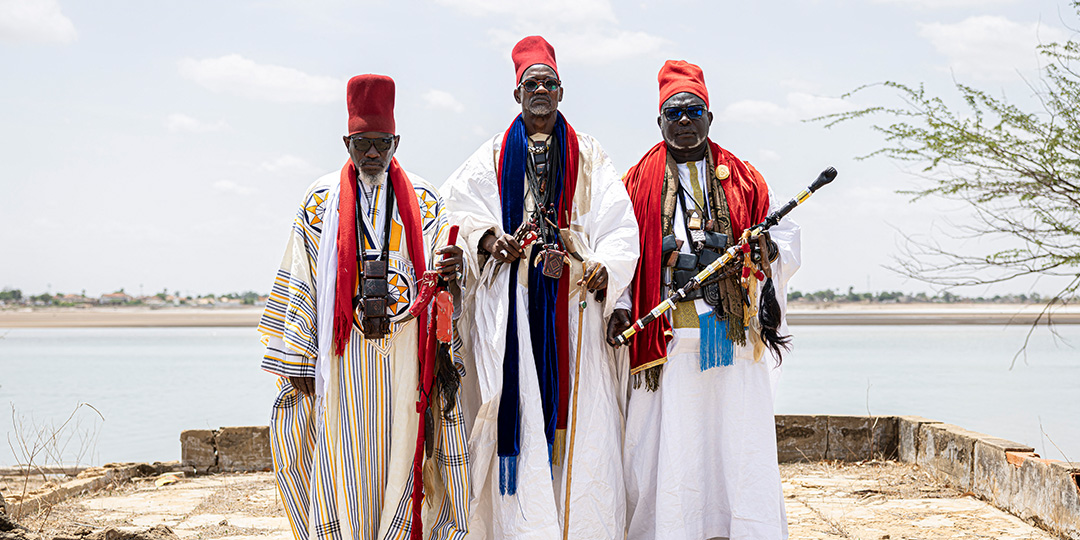The crowd sat rapt as Senegalese master fortune-teller Adama Gackou entered a trance to predict what the future holds for the west African country.
Dead silence reigned as Gackou, his face dimly lit up in the late-night shadows, foretold a tumultuous year of violent protest while swaying back and forth.
Then the tension lifted as the young mystic proclaimed a bumper harvest season to come, prompting a jubilant audience to break out into frenetic dance.
Bedecked in talismans, a large ox horn hanging from his chest, Gackou was just one of around 20 traditional fortune-tellers, known as “Saltigues” in Senegal, delivering their predictions during the annual ritual.
Several delegations from across the country had travelled to the Fatick region for the weekend’s “Xooy” ceremony, a tradition rooted in ancient African spirituality held ahead of the country’s rainy season.
From traffic accidents and natural disasters to celebrity deaths and even society gossip, no subject is off-limits for the Saltigues’ incantations.
His voice booming, Gackou warned of tensions at the top between President Bassirou Diomaye Faye, elected in 2024, and his Prime Minister and former mentor Ousmane Sonko.
“If they do not make the necessary sacrifices, they each risk going their separate ways by the 2029 presidential election,” the mystic thundered.
Besides their predictions of the future, the Saltigues can likewise recommend what sacrifice must be made to avoid those catastrophes.
– Confidants of kings –
The Xooy is primarily practised by the Serer ethnic group, though the Lebous people of the capital Dakar are also known to take part.
As an ancestral tradition transcending faiths, the ceremony is a keenly awaited event in Senegal.
According to the Saltigues, when the kings of the pre-colonisation Kingdom of Sine prepared for war, they would always consult the soothsayers before committing themselves to battle.
Though society may have changed, many Senegalese continue to believe in the supernatural and the Saltigues’ prophesies.
While admitting that many others do not, clairvoyant Abdoulaye Ndiaye insisted the Saltigues had warned the authorities to make offerings to prevent the sinking of the Le Joola ferry in 2002, which killed nearly 1,900 people.
A scarlet bonnet embellished with sea snail shells on his head, Ndiaye even insisted that his fellow mystics had predicted the Covid-19 pandemic.
As the tom-tom drums pounded, the mystics within the circle put on a show, each clad in distinctive charms decorated with mirrors, mummified bird heads or small white seashells.
Some stomped their chests to the beat, while others faced off against their fellow Saltigues in a magic-measuring contest.
– ‘Too good’ –
As Saturday turned into Sunday the Xooy dragged on, with the vigil lasting until the afternoon.
Gackou appeared to be the hot ticket of the 2025 edition, the audience’s eyes firmly fixed on him as he made offhand quips and snide remarks about his fellow mystics.
He told AFP he drew his predictive prowess from “djinns”, genies who read the future for him.
“He’s too good. Everything he foresees comes to pass,” said Amath Ndiaye, a young spectator from a village a few kilometres away.
Amath’s mystic namesake, Abdoulaye Ndiaye, explained that there were many ways to join the soothsayers’ ranks.
Some claim they were born clairvoyant or inherited the know-how from their parents.
For others, Ndiaye said, it took years of hard toil before the elders passed on the secret of reading the water, the wind, fires and seashells for clues as to what will come.
Many Saltigues also practise traditional African medicine.
El Hadji Malick Ngom, chief of the Saltigues of Dakar’s Lebous people, claimed the spirits helped the mystics diagnose diseases and prepare plant-based potions to cure them.
Yet he lamented that this native know-how was “very endangered” as the younger generations increasingly turn their backs on the tradition.
sjd/lp/sbk/rlp
© Agence France-Presse








